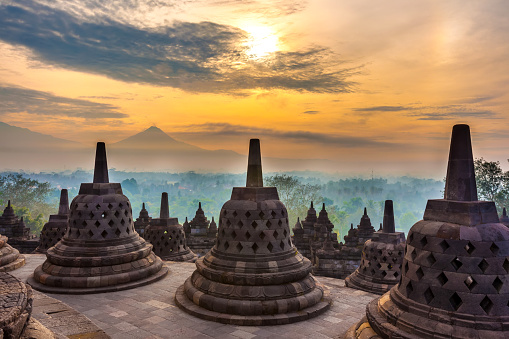Complete History
1. A Brief History of Borobudur Temple
According to historical records, the initial construction of Borobudur Temple occurred in the 8th and 9th centuries around 800 AD during the reign of the Syailendra dynasty. The construction of Borobudur is predicted to take tens to hundreds of years until it was completely completed during the reign of King Samaratungga in 825. Although it was completed, there are no historical records explaining who built Borobudur Temple. The reason is, at that time Hinduism and Buddhism developed simultaneously on the island of Java. The Syailendra dynasty was recorded as a follower of Mahayana Buddhism while around Borobudur there were also followers of Shiva Hinduism.

The structure then changed due to the addition of square and circular steps. Then, Borobudur underwent the last change in the circular steps and the foundation was widened. The splendor of Borobudur had disappeared for centuries because it was buried under layers of soil and volcanic dust which were then overgrown with trees and bushes to resemble a hill. It is not known for sure why Borobudur was abandoned by its inhabitants at that time. Historical theories point to the eruption of Mount Merapi and the change of the population's beliefs from Buddhism to Islam. The return of Borobudur Temple's fame occurred during the time of Thomas Stamford Raffles when he served as Governor General on the island of Java in 1811. The rediscovery occurred when Raffles heard that there was a large building hidden deep in the forest near the village of Bumisegoro. Raffles then sent a Dutch engineer named Christian Cornelius to examine it. The spread of news of the rediscovery of Borobudur also became a disaster that caused damage in many places. Until the late 1960s the Indonesian government asked UNESCO for help to overcome the problems at Borobudur Temple. In the history of Borobudur Temple, its renovation took a long time and cost a lot of money until it was designated as a World Heritage Site by UNESCO in 1991.
2. The shape of Borobudur Temple
As the largest Buddhist temple in the world and the largest Buddhist monument in the world, according to the Ministry of Education and Culture, Borobudur Temple has a structure like a terraced pyramid that gets smaller as it goes up, with four stairs in each direction of the compass.
Borobudur Temple is 121.66 meters long, 121.38 meters wide, and 35.40 meters high. According to Buddhist philosophy, the structure of the levels of Borobudur Temple is an imitation of the universe of the wheel of life. There are three levels in the structure of Borobudur Temple, namely:
- Kamadhatu : The lowest part of the temple which symbolizes the lower realm, depicts human behavior that is still bound by worldly desires.
- Rupadhatu : The middle part of the temple which symbolizes the intermediate realm, depicts human behavior that has begun to leave worldly desires, but is still bound by the real world.
- Arupadhatu : The upper part of the temple which symbolizes the upper realm, depicts intangible elements and as a sign of levels that have abandoned worldly desires.
The stones at Borobudur Temple are predicted to come from the rivers around Borobudur with a total volume of around 55,000 cubic meters, equivalent to 2 million pieces of stone.









